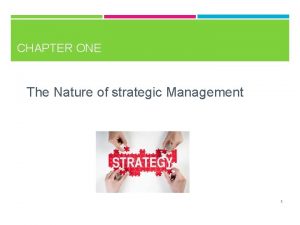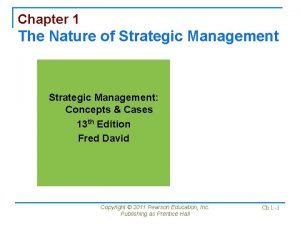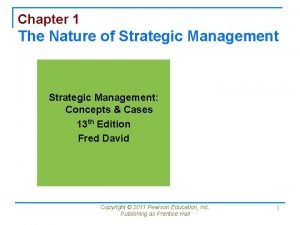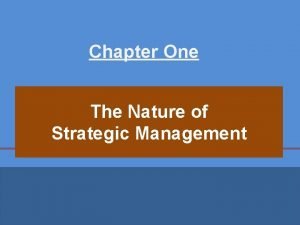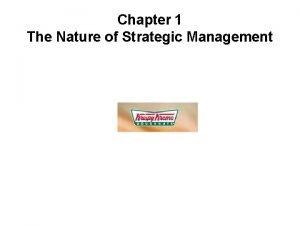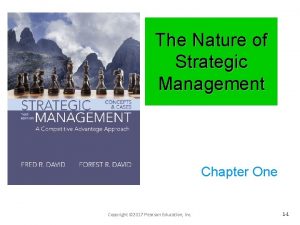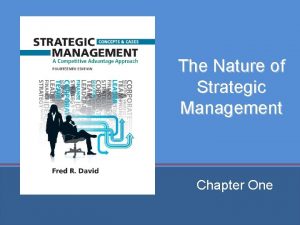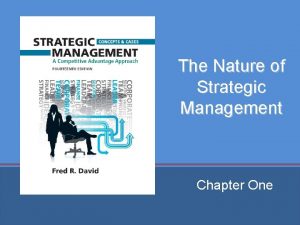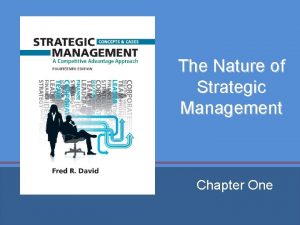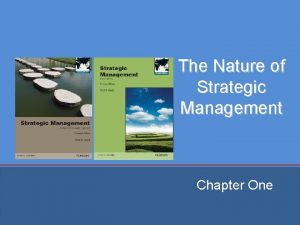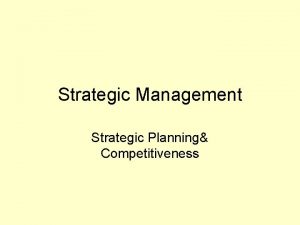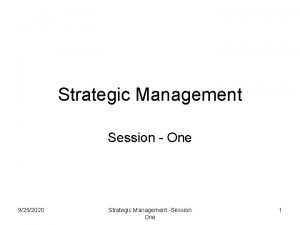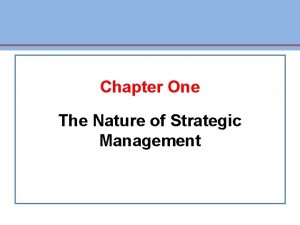THE NATURE OF STRATEGIC MANAGEMENT Chapter One Copyright






















- Slides: 22

THE NATURE OF STRATEGIC MANAGEMENT Chapter One Copyright © 2015 Pearson Education, Inc 1 -1

DEFINING STRATEGIC MANAGEMENT ► Strategic management ► the art and science of formulating, implementing, and evaluating cross-functional decisions that enable an organization to achieve its objectives Copyright © 2015 Pearson Education, Inc 1 -2

A COMPREHENSIVE STRATEGICMANAGEMENT MODEL Copyright © 2015 Pearson Education, Inc 1 -3

DEFINING STRATEGIC MANAGEMENT ► Strategic management is used synonymously with the term strategic planning. ► Sometimes the term strategic management is used to refer to strategy formulation, implementation, and evaluation, with strategic planning referring only to strategy formulation. Copyright © 2015 Pearson Education, Inc 1 -4

DEFINING STRATEGIC MANAGEMENT ►A strategic plan is a company’s game plan. ► A strategic plan results from tough managerial choices among numerous good alternatives, and it signals commitment to specific markets, policies, procedures, and operations. Copyright © 2015 Pearson Education, Inc 1 -5

STAGES OF STRATEGIC MANAGEMENT Strategy formulation Strategy implementation Copyright © 2015 Pearson Education, Inc Strategy evaluation 1 -6

STAGES OF STRATEGIC MANAGEMENT ► Strategy formulation ► includes developing a vision and mission, identifying an organization’s external opportunities and threats, determining internal strengths and weaknesses, establishing longterm objectives, generating alternative strategies, and choosing particular strategies to pursue. Copyright © 2015 Pearson Education, Inc 1 -7

STAGES OF STRATEGIC MANAGEMENT ► Strategy implementation ► requires a firm to establish annual objectives, devise policies, motivate employees, and allocate resources so that formulated strategies can be executed ► often called the action stage Copyright © 2015 Pearson Education, Inc 1 -8

KEY TERMS IN STRATEGIC MANAGEMENT ► Internal strengths and internal weaknesses ► an organization’s controllable activities that are performed especially well or poorly ► determined relative to competitors Copyright © 2015 Pearson Education, Inc 1 -9

KEY TERMS IN STRATEGIC MANAGEMENT ► Objectives ► specific results that an organization seeks to achieve in pursuing its basic mission ► long-term means more than one year ► should be challenging, measurable, consistent, reasonable, and clear Copyright © 2015 Pearson Education, Inc 1 -10

KEY TERMS IN STRATEGIC MANAGEMENT ► Strategies ► the means by which long-term objectives will be achieved ► may include geographic expansion, diversification, acquisition, product development, market penetration, retrenchment, divestiture, liquidation, and joint ventures Copyright © 2015 Pearson Education, Inc 1 -11

KEY TERMS IN STRATEGIC MANAGEMENT ► Annual objectives ► short-term milestones that organizations must achieve to reach long-term objectives ► should be measurable, quantitative, challenging, realistic, consistent, and prioritized ► should be established at the corporate, divisional, and functional levels in a large organization Copyright © 2015 Pearson Education, Inc 1 -12

KEY TERMS IN STRATEGIC MANAGEMENT ► Policies ► the means by which annual objectives will be achieved ► include guidelines, rules, and procedures established to support efforts to achieve stated objectives ► guides to decision making and address repetitive or recurring situations Copyright © 2015 Pearson Education, Inc 1 -13

THE STRATEGIC-MANAGEMENT MODEL Where are we now? Where do we want to go? How are we going to get there? Copyright © 2015 Pearson Education, Inc 1 -14

BENEFITS OF STRATEGIC MANAGEMENT ► Historically, the principal benefit of strategic management has been to help organizations formulate better strategies through the use of a more systematic, logical, and rational approach to strategic choice Copyright © 2015 Pearson Education, Inc 1 -15

BENEFITS OF STRATEGIC MANAGEMENT ► Communication is a key to successful strategic management ► Through dialogue and participation, managers and employees become committed to supporting the organization 1 -16 Copyright © 2015 Pearson Education, Inc

BENEFITS TO A FIRM THAT DOES STRATEGIC PLANNING Copyright © 2015 Pearson Education, Inc 1 -17

FINANCIAL BENEFITS ► Businesses using strategic-management concepts show significant improvement in sales, profitability, and productivity compared to firms without systematic planning activities ► High-performing firms seem to make more informed decisions with good anticipation of both short- and long-term consequences Copyright © 2015 Pearson Education, Inc 1 -18

NONFINANCIAL BENEFITS Enhanced awareness of external threats, ► Improved understanding of competitors’ strategies, ► Increased employee productivity, ► Reduced resistance to change, ► Clearer understanding of performance– reward relationships. ► Copyright © 2015 Pearson Education, Inc 1 -19

NONFINANCIAL BENEFITS ► Increased discipline ► Improved coordination ► Enhanced communication ► Increased forward thinking ► Improved decision-making ► Increased synergy ► Effective allocation of time and resources Copyright © 2015 Pearson Education, Inc 1 -20

WHY SOME FIRMS DO NO STRATEGIC PLANNING ► Lack of knowledge in strategic planning ► Poor reward structures ► Firefighting ► Waste of time ► Too expensive Copyright © 2015 Pearson Education, Inc 1 -21

WHY SOME FIRMS DO NO STRATEGIC PLANNING ► Laziness ► Content with success ► Overconfidence ► Prior bad experience ► Honest difference of opinion Copyright © 2015 Pearson Education, Inc 1 -22
 Strategic management nature
Strategic management nature Resource based model
Resource based model Cultural aspects of strategy choice
Cultural aspects of strategy choice Nature and scope of strategic management
Nature and scope of strategic management Nature of strategic management
Nature of strategic management The nature of strategic management
The nature of strategic management Bestbuyq
Bestbuyq Copyright
Copyright Nature of strategic management
Nature of strategic management Nature of strategy
Nature of strategy One empire one god one emperor
One empire one god one emperor Little dog run
Little dog run One king one law one faith
One king one law one faith One empire one god one emperor
One empire one god one emperor Ford one plan
Ford one plan See one do one teach one
See one do one teach one See one, do one, teach one
See one, do one, teach one Structure of twelfth night
Structure of twelfth night See one do one teach one
See one do one teach one Asean tourism strategic plan
Asean tourism strategic plan Graphic organizer with the aims of la liga filipina
Graphic organizer with the aims of la liga filipina Strategic fit vs strategic intent
Strategic fit vs strategic intent Strategic substitutes example
Strategic substitutes example
